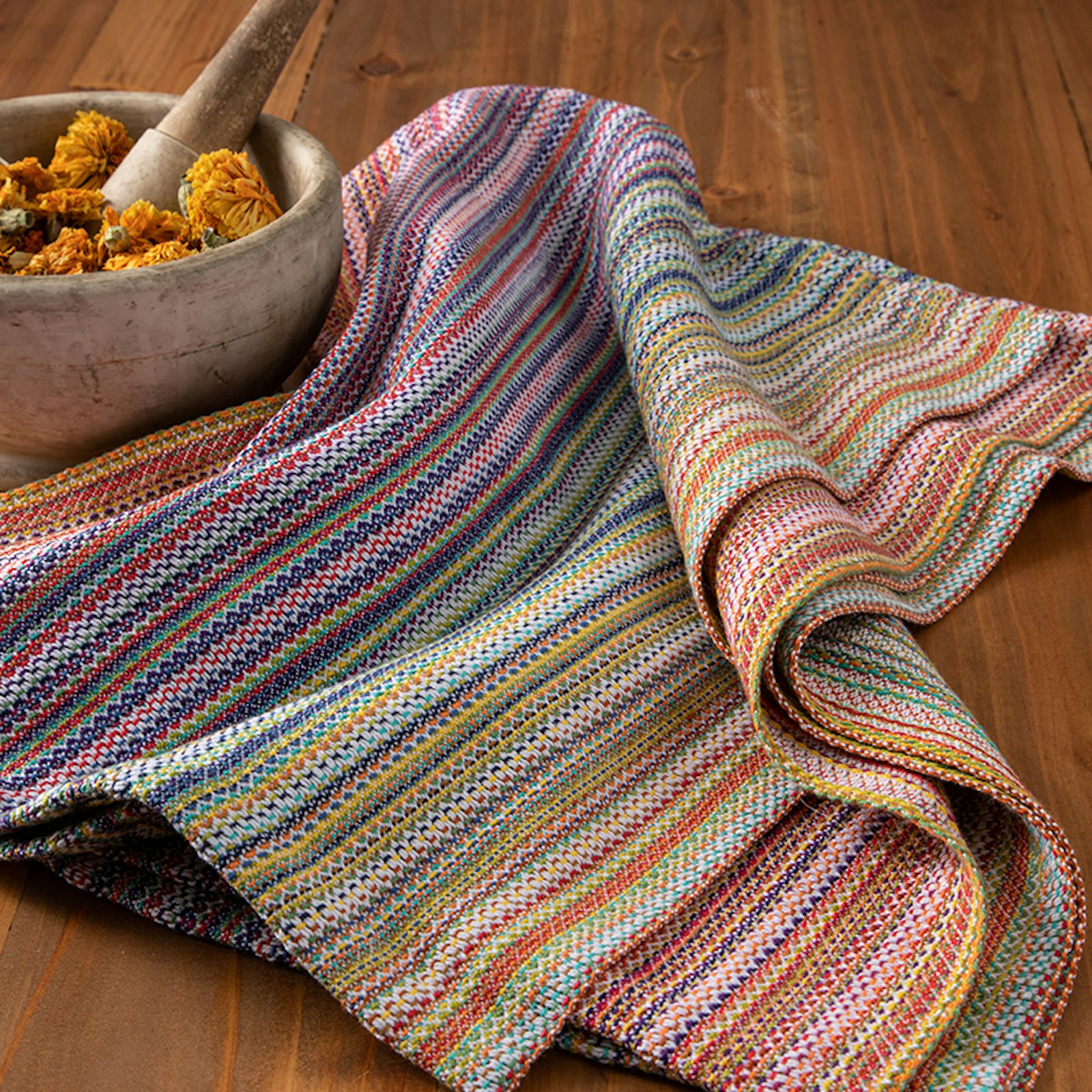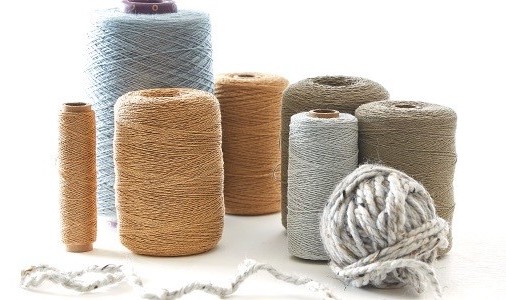Subscriber Exclusive
Coping with Harness Envy: Reducing Multi-shaft Drafts to 4-shafts
It's frustrating to love an 8-shaft pattern when you only have a 4-shaft loom. In this article from March/April 2018, Madelyn describes how to reduce 8-shaft twill drafts to 4-shafts. We tried her methods on some recent drafts, check out our results!
Four-shaft looms are very versatile, but sometimes you might fall in love with a handwoven fabric only to be frustrated when you realize it uses more shafts than you have available. This article by Madelyn van der Hoogt from Handwoven March/April 2018 explains how you can reduce 6- and 8-shaft twill drafts to 4-shaft versions. One of the examples she gives is an M and W twill that exactly matched Kathie Roig's Random Exchange Towels from September/October 2021, so that one was easy. Then I tried both of her methods on Annette Schipf's 8-shaft twill draft for her Stormy Days Jacket from September/October 2022.
If you are a current subscriber to Handwoven magazine, log in below to read the article and practice the techniques. Then check your results using the attached downloadable pdfs, and you are ready to branch out on your own! - Susan
 Annette Schipf's Stormy Days Jacket is an 8-shaft twill. The 4-shaft version I developed using Madelyn's methods is similar but not exactly the same. Photo by Julia Vandenoever
Annette Schipf's Stormy Days Jacket is an 8-shaft twill. The 4-shaft version I developed using Madelyn's methods is similar but not exactly the same. Photo by Julia Vandenoever
Two Methods for Reducing Multi-shaft Twill Designs to 4-Shafts
I bought my first loom based on the only word about it that I understood— “cherry.” I didn’t know what a harness was, how a friction brake worked, or what “weaving width” really meant. My “cherry” Norwood just happened to have four shafts. After a short while, I began to believe that more shafts meant better weaving.
As I added looms to my collection (one with as many as 32 shafts), I soon learned that more shafts do not mean better weaving. Craftsmanship, successful designs, appealing color interaction, suitable fabric textures—none of these is dependent on the number of shafts on a loom. More shafts do bring some design advantages, especially when moving from four to eight, but the advantages decrease proportionately as the number of shafts increase. The greatest advantages occur when moving from two shafts to four, not as great when moving from four to eight, even less when moving from eight to twelve, and so on. Basically, more shafts allow fancier twills and more pattern blocks.
A weaver with a four-shaft loom can take great joy in its infinite pattern potential; just leaf through Davison and Dixon and check out all the drafts for overshot, laces, and twills. This is sometimes not enough consolation, however, when you want to weave a project in Handwoven that requires eight shafts, and you only have four.
Many of these projects are likely to be woven in twill (for towels, blankets, runners, clothing, etc.). The good news is that you can reduce most multi-shaft twill designs to four shafts. The sacrifice is usually in float length: Twills on more than four shafts allow longer floats and more varied float length. Even so, you can weave similar pieces on your four-shaft loom using the project instructions.
Reducing twills: Method 1
To do this, first think of twill threadings as circular, progressing in a direction, either 1-2-3-4 (clockwise) or 4-3-2-1 counterclockwise.
Four-shaft looms are very versatile, but sometimes you might fall in love with a handwoven fabric only to be frustrated when you realize it uses more shafts than you have available. This article by Madelyn van der Hoogt from Handwoven March/April 2018 explains how you can reduce 6- and 8-shaft twill drafts to 4-shaft versions. One of the examples she gives is an M and W twill that exactly matched Kathie Roig's Random Exchange Towels from September/October 2021, so that one was easy. Then I tried both of her methods on Annette Schipf's 8-shaft twill draft for her Stormy Days Jacket from September/October 2022.
If you are a current subscriber to Handwoven magazine, log in below to read the article and practice the techniques. Then check your results using the attached downloadable pdfs, and you are ready to branch out on your own! - Susan
 Annette Schipf's Stormy Days Jacket is an 8-shaft twill. The 4-shaft version I developed using Madelyn's methods is similar but not exactly the same. Photo by Julia Vandenoever
Annette Schipf's Stormy Days Jacket is an 8-shaft twill. The 4-shaft version I developed using Madelyn's methods is similar but not exactly the same. Photo by Julia Vandenoever
Two Methods for Reducing Multi-shaft Twill Designs to 4-Shafts
I bought my first loom based on the only word about it that I understood— “cherry.” I didn’t know what a harness was, how a friction brake worked, or what “weaving width” really meant. My “cherry” Norwood just happened to have four shafts. After a short while, I began to believe that more shafts meant better weaving.
As I added looms to my collection (one with as many as 32 shafts), I soon learned that more shafts do not mean better weaving. Craftsmanship, successful designs, appealing color interaction, suitable fabric textures—none of these is dependent on the number of shafts on a loom. More shafts do bring some design advantages, especially when moving from four to eight, but the advantages decrease proportionately as the number of shafts increase. The greatest advantages occur when moving from two shafts to four, not as great when moving from four to eight, even less when moving from eight to twelve, and so on. Basically, more shafts allow fancier twills and more pattern blocks.
A weaver with a four-shaft loom can take great joy in its infinite pattern potential; just leaf through Davison and Dixon and check out all the drafts for overshot, laces, and twills. This is sometimes not enough consolation, however, when you want to weave a project in Handwoven that requires eight shafts, and you only have four.
Many of these projects are likely to be woven in twill (for towels, blankets, runners, clothing, etc.). The good news is that you can reduce most multi-shaft twill designs to four shafts. The sacrifice is usually in float length: Twills on more than four shafts allow longer floats and more varied float length. Even so, you can weave similar pieces on your four-shaft loom using the project instructions.
Reducing twills: Method 1
To do this, first think of twill threadings as circular, progressing in a direction, either 1-2-3-4 (clockwise) or 4-3-2-1 counterclockwise. [PAYWALL] Under the draft you want to reduce (see the six-shaft draft in Figure 1a, for example), rewrite the draft on four rows starting in the same direction, clockwise here (1b). When you come to shaft 4, and the threading continues to shafts 5 and 6 in the six-shaft draft, wrap back to shaft 1 in the four-shaft draft. Use the original shaft numbers as you do this so you can keep track of where you are. When the twill changes direction in the six-shaft draft, change direction in the four-shaft draft, no matter what shaft you are on. Compare Figures 1a and 1b; twill direction changes on the shafts shown in red in 1b. The last step is to rewrite the shaft numbers; see Figure 1c.
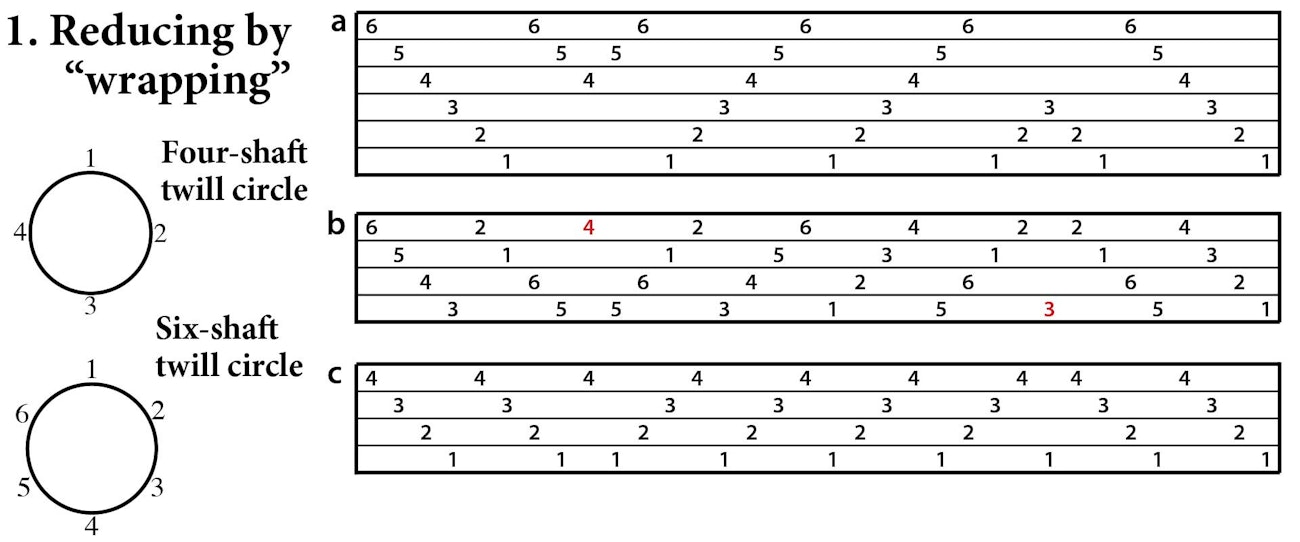
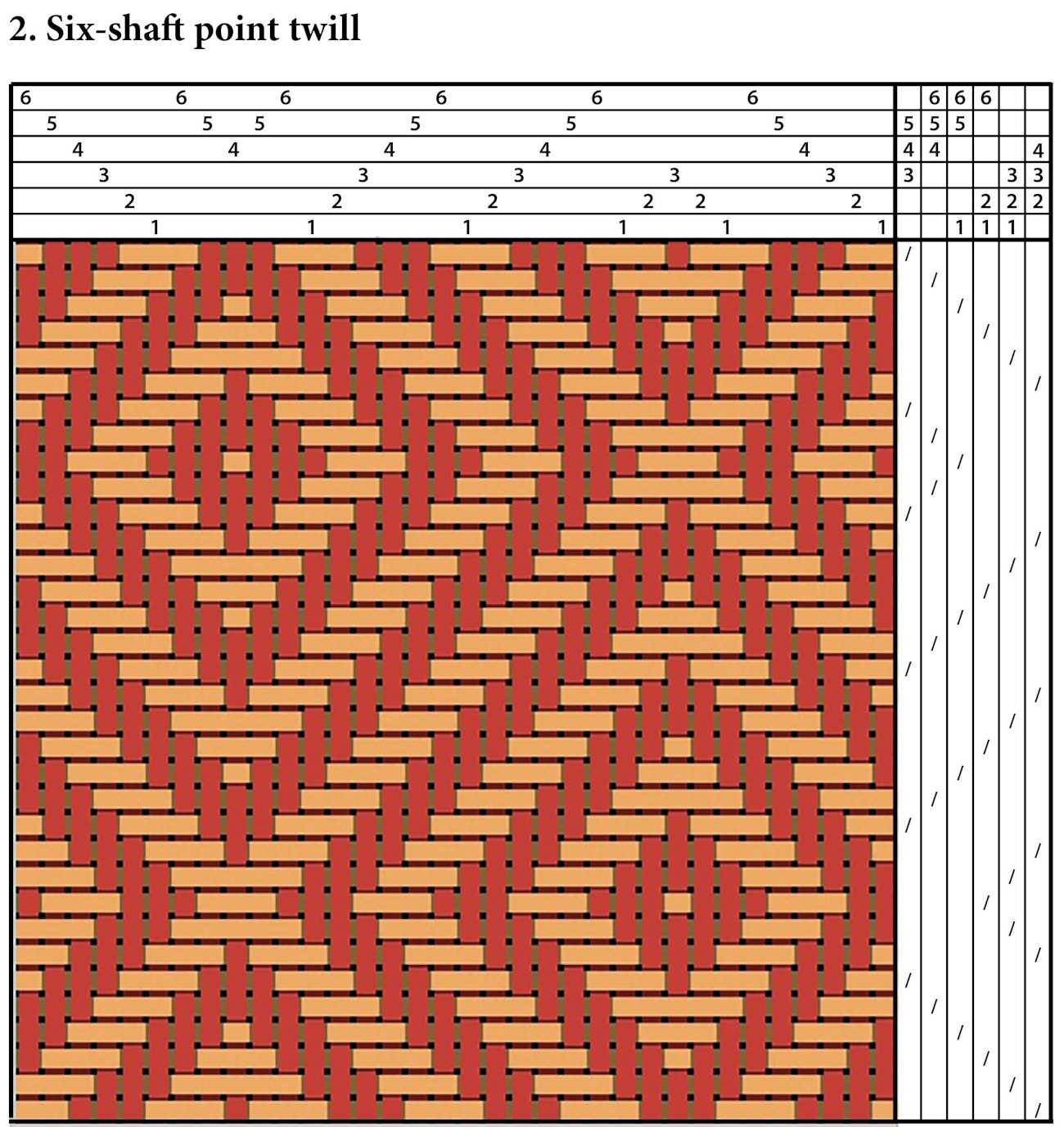
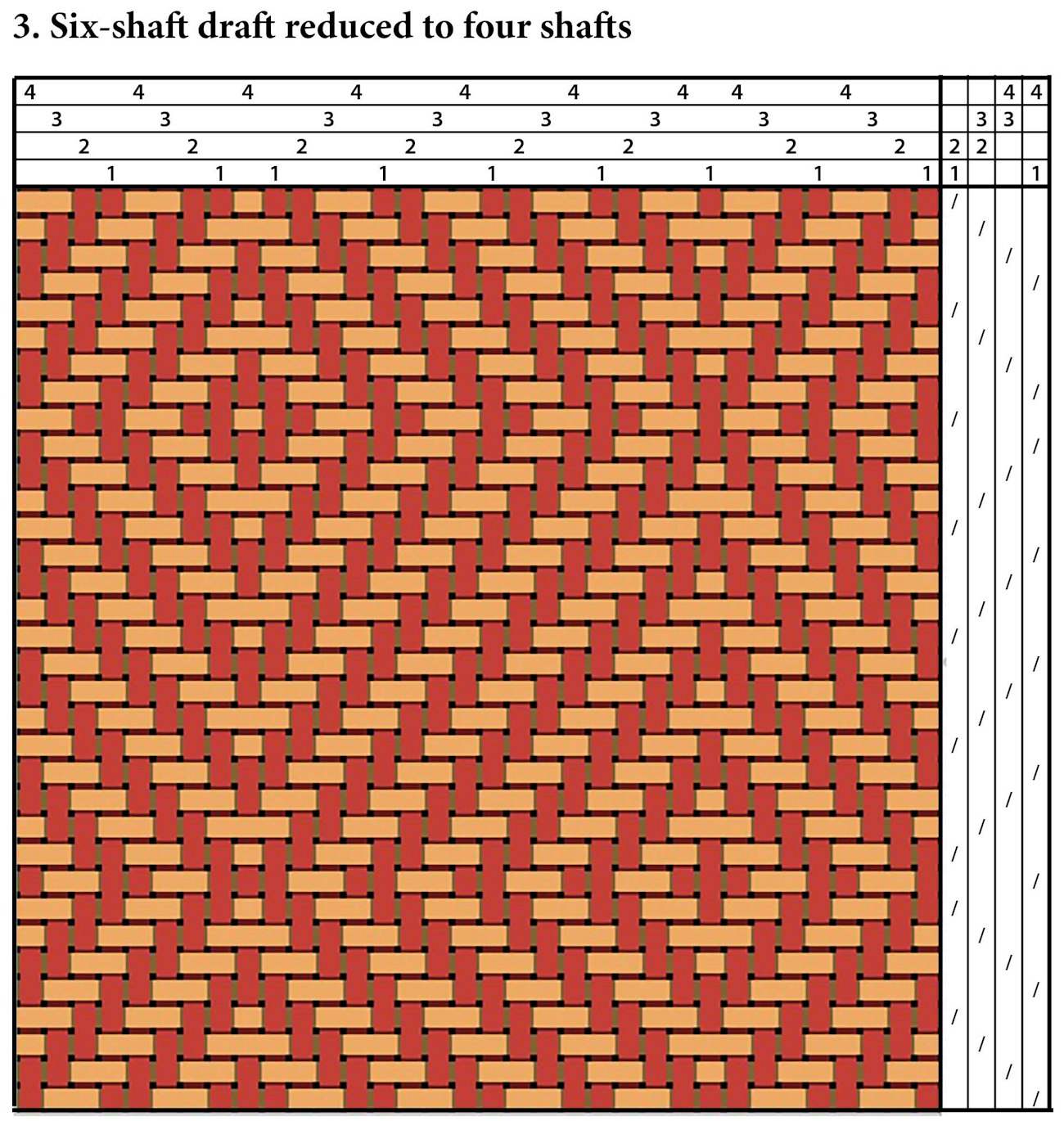
Reducing twills: Method 2
If the twill draft you are reducing has eight shafts (or other multiples of four), as in Figure 4a, you can reduce the draft by telescoping. Below the eight-shaft draft, write the new draft with shafts 1–4 placed exactly where they are in the eight-shaft draft. Then place the numbers from shafts 5–8 on rows 1–4 in the new draft (red in 4b). The last step is to rewrite the numbers as in 4c.

The Tie-up
Twills on four shafts can be woven with 1/3, 2/2, or 3/1 twill tie-ups. Both Figures 3 and 6 are woven in 2/2 twill. Notice that the four-shaft designs are the same as their respective designs on six and eight shafts. The difference is in float length; compare the drawdown in Figure 3 with the one in Figure 2 and the drawdown in Figure 6 with the one in Figure 5.
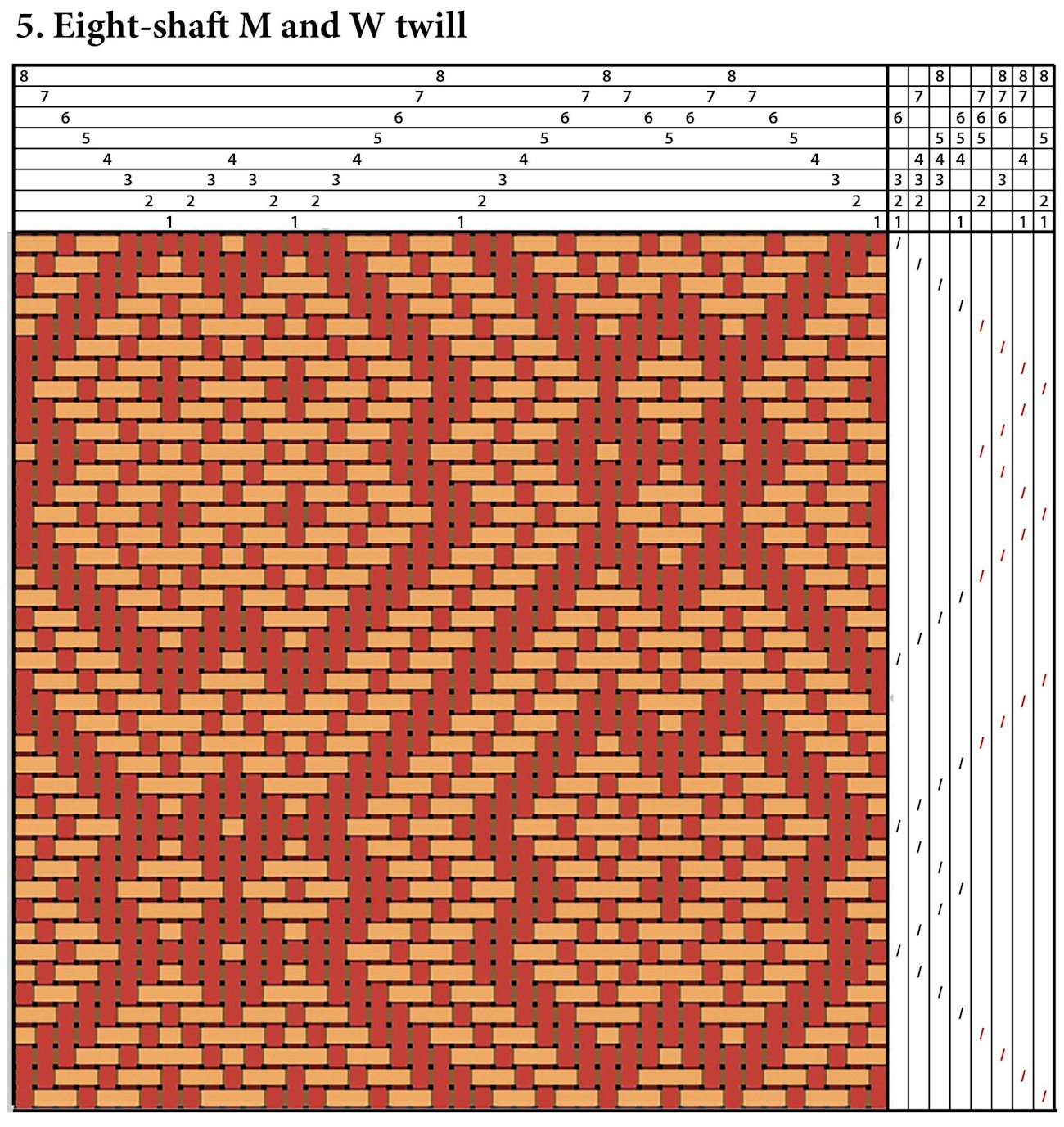
The Treadling
The treadling orders for both the six-shaft and eight-shaft drafts shown here are “tromp as writ”; i.e., the treadling order is the same as the threading order. The new treadling can therefore be written by following the new threading. If this is not the case, the treadling can be reduced using the same method as for the threading, by wrapping or telescoping. In Figure 5, treadling marks for treadles 5–8 are shown in red and “telescoped” to their positions on treadles 1–4 in Figure 6.
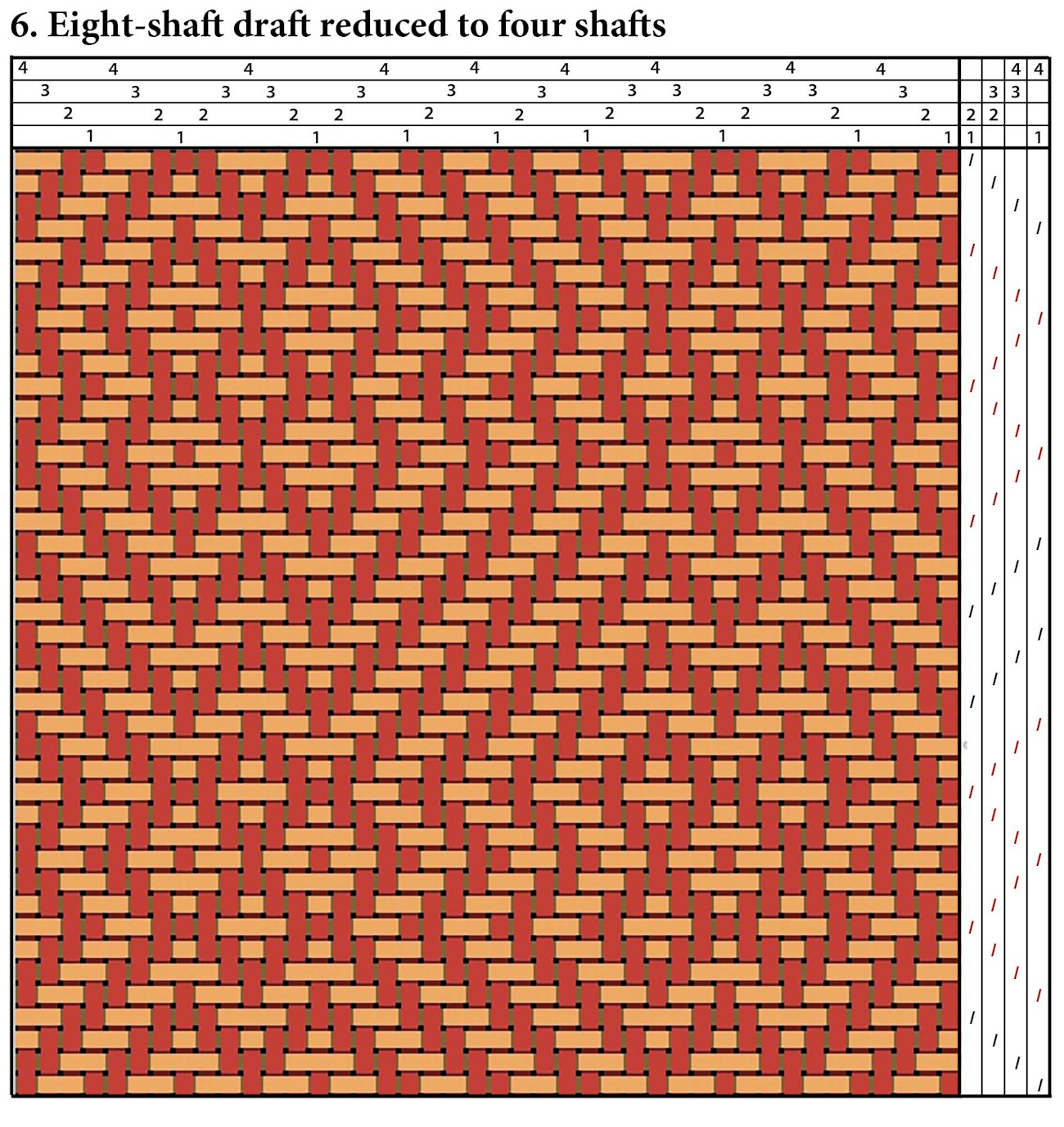
As promised, here are the pdfs with the original drafts and the reduced versions for the Random Exchange Towels
and the Stormy Days Jacket. We've also added the 4-shaft versions to the WIF library.
Resources
- Davison, Marguerite Porter. A Handweaver’s Pattern Book. Swarthmore, Pennsylvania: Marguerite Porter Davison, 1977.
- Dixon, Anne. The Handweaver’s Pattern Directory. Loveland, Colorado: Interweave, 2007.
 Annette Schipf's Stormy Days Jacket is an 8-shaft twill. The 4-shaft version I developed using Madelyn's methods is similar but not exactly the same. Photo by Julia Vandenoever
Annette Schipf's Stormy Days Jacket is an 8-shaft twill. The 4-shaft version I developed using Madelyn's methods is similar but not exactly the same. Photo by Julia Vandenoever
